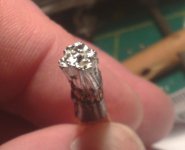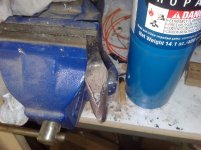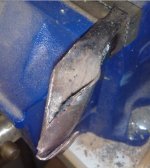I'll try and post some pics tonight.
Just found my phone to USB connector - here's those pics.
Attachments
wouldnt a small HV shunt cap across each driver(or both) do the same thing? yknow kinda like they used to do on many speakers years ago, although for a different purpose........ie...um lets see......1pF or so, 1500V, a few paralleled together to get a greater plate surface area, and hence more reserve electrons.
mondogenerator
So, try all three orientations. Across the poles, with only one end attached to the ground going terminal and, assuming it is a bipolar cap, with both legs shorted to the same negative going terminal. As a control, find two feet of lamp cord, strip a few inches from both ends, make a loop and slip them under the negative going lug. Except for slightly altering a crossover value in one instance, you cannot damage anything.
Bud
So, try all three orientations. Across the poles, with only one end attached to the ground going terminal and, assuming it is a bipolar cap, with both legs shorted to the same negative going terminal. As a control, find two feet of lamp cord, strip a few inches from both ends, make a loop and slip them under the negative going lug. Except for slightly altering a crossover value in one instance, you cannot damage anything.
Bud
This recent activity reminded me to post about my trials with the Litz wire. So far I've found no solvents (acetone, alcohol) that work to remove the lacquer coating. Dipping it in a homemade solder pot (per Alex's suggestion) didn't work either. Solder "pot" was heated with a propane torch, then loop dipped in, but nothing happened.
I was able to burn off the enamel with a torch, but it tended to make a mess of carbonized material that I had to wire brush off (not all came off this way) and I still couldn't get the silver solder that I normally use to take. Loop ends would come out solder-free.
I'll keep trying.
On another front, here's my findings on trying one loop pair (I was able to get this pair partially soldered) on a pair of speakers driven by a 1 watt DIY SET. I thought I could hear a bit of a difference - maybe some more air and sparkle on highs and perhaps some changes to bass response, but I wasn't sure. Only about 15 mins of listening or so. I then tried removing the loops while the music continued to play. Oddly, I heard no discernible difference in the sound. Then tried to touch and remove the loops to the negative terminal and again heard no difference.
If the loops were doing something noticeable, I'd expect to have heard a difference. In particular, if the loops are somehow "charging" up, then I'd at least expect to hear a change when I remove them. Could be that I hadn't fully removed the lacquer coating nor fully soldered them, so I'm reserving judgement. Perhaps it could also be that I wasn't fully in front of the speakers when doing this, nor in any decent listening position.
Anyway, I'd be interested in any thoughts about what audible effect, if any, would happen if one were to remove the loops WHILE continuing to play music. I can't figure out if there's a flaw in my logic here.
Carl
I was able to burn off the enamel with a torch, but it tended to make a mess of carbonized material that I had to wire brush off (not all came off this way) and I still couldn't get the silver solder that I normally use to take. Loop ends would come out solder-free.
I'll keep trying.
On another front, here's my findings on trying one loop pair (I was able to get this pair partially soldered) on a pair of speakers driven by a 1 watt DIY SET. I thought I could hear a bit of a difference - maybe some more air and sparkle on highs and perhaps some changes to bass response, but I wasn't sure. Only about 15 mins of listening or so. I then tried removing the loops while the music continued to play. Oddly, I heard no discernible difference in the sound. Then tried to touch and remove the loops to the negative terminal and again heard no difference.
If the loops were doing something noticeable, I'd expect to have heard a difference. In particular, if the loops are somehow "charging" up, then I'd at least expect to hear a change when I remove them. Could be that I hadn't fully removed the lacquer coating nor fully soldered them, so I'm reserving judgement. Perhaps it could also be that I wasn't fully in front of the speakers when doing this, nor in any decent listening position.
Anyway, I'd be interested in any thoughts about what audible effect, if any, would happen if one were to remove the loops WHILE continuing to play music. I can't figure out if there's a flaw in my logic here.
Carl
Thanks, Dave. You remind me that what you describe as the effect - a reserve for dynamic swings - might just explain what I thought I was hearing. Would also explain why I didn't hear any difference when I removed them and touched them back to the neg terminal. I'll do some more critical listening when I get a chance.
This recent activity reminded me to post about my trials with the Litz wire. So far I've found no solvents (acetone, alcohol) that work to remove the lacquer coating. Dipping it in a homemade solder pot (per Alex's suggestion) didn't work either. Solder "pot" was heated with a propane torch, then loop dipped in, but nothing happened.
G'day Carl,
The solder pot has to be really hot. Just melting the solder is not enough.
I heat my solder pot to the point where it begins to glow orange.
I also dip the tail in isopropyl alcohol, give it a quick shake and then dip it into the solder. Seems to allow the solder to flow more easily.
Please make sure you use safety glasses for this! (I know you do Carl
No point giving your ears a treat if it costs an eye!
Cheers,
Alex
Hi Carl,
Just as Alex notes, very hot indeed. We run out commercial pots at 580 F for 60/40 lead tin and 640 F for silver solder. We use a kester liquid flux, one that can be cut with alcohol and mix it with the alcohol to a weak tea color. This allows the alcohol to ablate the wire insulation and the remaining light flux to insure complete solder contact with the brite clean copper/ For Litz this is the only sane way to progress. May I suggest that you check around in your local area for either transformer companies or motor rewind shops. Both will have commercial solder pots available and can tin your wires in a few seconds.
If you can fins no one PM me and you can send me your wires and I will tin them for you.
Bud
Just as Alex notes, very hot indeed. We run out commercial pots at 580 F for 60/40 lead tin and 640 F for silver solder. We use a kester liquid flux, one that can be cut with alcohol and mix it with the alcohol to a weak tea color. This allows the alcohol to ablate the wire insulation and the remaining light flux to insure complete solder contact with the brite clean copper/ For Litz this is the only sane way to progress. May I suggest that you check around in your local area for either transformer companies or motor rewind shops. Both will have commercial solder pots available and can tin your wires in a few seconds.
If you can fins no one PM me and you can send me your wires and I will tin them for you.
Bud
In a more general sense, here is another review from 6 moons.
6moons audio reviews: AudioPrism GroundControl thanks to nicoch46 for pointing me towards it.
The other review noted is a bit vexing. I was sent a pre-copy of it to correct, but the corrections did not take for some reason or other.
So, I want to make it clear, I NEVER worked for McIntosh labs, much as I would have been honored to do so. I did work for Mille' Nestorovic and did redesign the power and output transformers for his NA 1 mono block amps. Not to improve their potential performance, but to make them repeatable in a manufactured environment. Caused Bob Greenburg to scuff his shoes and curse because he still had some of the old OPT's, none of which had even remotely similar specs, and here he had 40 new ones and all of them were identical to each other, but matched none of the older ones either.
Bud
6moons audio reviews: AudioPrism GroundControl thanks to nicoch46 for pointing me towards it.
The other review noted is a bit vexing. I was sent a pre-copy of it to correct, but the corrections did not take for some reason or other.
So, I want to make it clear, I NEVER worked for McIntosh labs, much as I would have been honored to do so. I did work for Mille' Nestorovic and did redesign the power and output transformers for his NA 1 mono block amps. Not to improve their potential performance, but to make them repeatable in a manufactured environment. Caused Bob Greenburg to scuff his shoes and curse because he still had some of the old OPT's, none of which had even remotely similar specs, and here he had 40 new ones and all of them were identical to each other, but matched none of the older ones either.
Bud
What do you guys think of this? It's a PDF of a small cheap way to make a solder pot. Just not sure if would be big enough for 15 gauge.
http://www.qrpkits.com/files/MiniSolderPot.pdf
http://www.qrpkits.com/files/MiniSolderPot.pdf
....
...... for his NA 1 mono block amps......
Bud
Bud , once or twice you said that you'll send me some schematics of Mile's amp .....
just to freshen your memory
6moons audio reviews: AudioPrism GroundControl
"Major Tom to .... "
This is complete rubbish. I just got of the floor from laughing so hard. How can people who know nothing about physics get away with these lies.
" and a proximate storage for electrons representing the negative half of all signal activity, significant because these local electrons composed a mirror image of the circuit components for every electrostatic moment. These electrostatic moments occur in electrical fields when there is a vector change in that field"
So whats responsible for the positive half of the waveform, magic crystals?
"Major Tom to .... "
This is complete rubbish. I just got of the floor from laughing so hard. How can people who know nothing about physics get away with these lies.
" and a proximate storage for electrons representing the negative half of all signal activity, significant because these local electrons composed a mirror image of the circuit components for every electrostatic moment. These electrostatic moments occur in electrical fields when there is a vector change in that field"
So whats responsible for the positive half of the waveform, magic crystals?
Well, you've heard of them I think. Transistors and resistors, you know, that M&M stuff you see on some of those weird green boards.
Find and read Ralph Morrison's book on "Grounding and Shielding". It's all pictures, so very easy to understand, especially since he claims that just one solution, mathematically, would take acres of paper to print. Pay close attention to what Ralph shows happening between components, wire, etc. and a not so distant ground plane and then think out of the box a bit.
Bud
Find and read Ralph Morrison's book on "Grounding and Shielding". It's all pictures, so very easy to understand, especially since he claims that just one solution, mathematically, would take acres of paper to print. Pay close attention to what Ralph shows happening between components, wire, etc. and a not so distant ground plane and then think out of the box a bit.
Bud
- Status
- This old topic is closed. If you want to reopen this topic, contact a moderator using the "Report Post" button.
- Home
- Design & Build
- Parts
- Groundside Electrons


